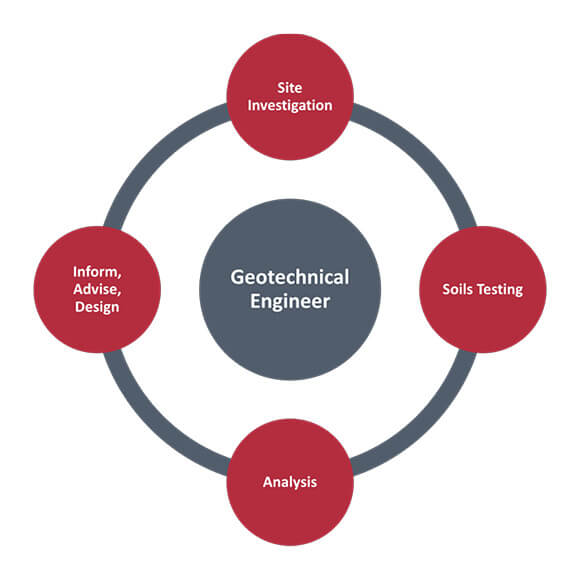A Biased View of Geotheta
A Biased View of Geotheta
Blog Article
The Facts About Geotheta Revealed
Table of ContentsMore About GeothetaThe Only Guide to GeothetaGetting The Geotheta To WorkGeotheta Can Be Fun For Everyone
They work together with civil designers, structural designers, architects, and various other professionals to integrate geotechnical considerations right into the total task layout and construction process. This requires reliable team effort, control, and interaction to ensure that the geotechnical aspects align with the project objectives and fulfill regulatory requirements.Mining & Products Engineering: Concepts of boring, penetration prices, and variables influencing the option of exploration method. Characteristics of dynamites, shooting systems and blast patterns. Blasting methods in surface and below ground workings. Unique blasting techniques at excavation perimeters. Vibration and noise control. Mechanical and continual strategies to fragmentation, including longwall shearing and fullface boring.
Integrated analysis of fragmentation and comminution operations. Offered by: Mining & Products Engineering.
Some Ideas on Geotheta You Should Know
Bachelor's level programs in civil, geotechnical, geological, and ecological design typically last 4 years and consist of basic education and learning courses in English, social scientific research, and the humanities, in addition to programs in innovative maths, structural geology, and fluid mineralogy. (https://giphy.com/channel/geotheta)
Geotechnical design involves the analysis of the soil and rock conditions at a certain site, and their ramifications for the growth of that website. As many frameworks depend on the ground for support, it lacks shock that a thorough understanding of the ground conditions, and the suitability of foundation systems, are important to the long-lasting security and efficiency of the building or structure.
Specialising in the investigation of geological formations and ground behavior, geotechnical engineers execute clinical examinations and screening to understand the effect these geological developments may have on the layout and building and construction of building, civil and facilities jobs. This know-how is crucial for the design and construction of buildings, roadways, passages, dams, bridges, and water supply and sewer system.
The geotechnical group at Douglas Allies routinely seek advice from engineers, style designers, designers, and building contractors to make recommendations on layout and growth propositions to ensure that the constructed frameworks are accordingly created for the ground conditions. For example, the style of footing systems needs to think about the weight of the structure, the ability of the ground to sustain that weight along with motion tolerances and efficient building.
The Ultimate Guide To Geotheta
This task is significantly streamlined by the use our Douglas Map geospatial system that makes this information conveniently easily accessible in a simple to make use of web internet browser interface. A geotechnical engineer will direct the boring of boreholes and test pits to collect soil and various other samples, and likewise evaluate surface area functions and ground exposures to develop a geotechnical model of the subsurface problems.
Depending upon the task type and ground problems ran into, lab screening may amongst various other points analyze stamina, compressibility, sensitivity and/or permeability of dirt and rock examples. After this data is accumulated and collated, the results are used for a geotechnical design of the website, which is normally offered as sections throughout the website.

A geotechnical examination by nature can only analyze the ground problems at the locations drilled or excavated. Natural variations in dirt and rock problems can happen throughout a website and in between examination areas. It is for that reason great method that the geotechnical engineer be retained throughout building of the project to supply on-site verification that the ground problems run into follow the assumptions and advice given in the geotechnical investigation report.
The Only Guide to Geotheta
Geotechnical designers utilize their thorough knowledge of soil and rock to evaluate risk and address troubles on varied infrastructure projectsGeotechnical engineering is a specialist branch of civil design which considers the behavior of planet products and the application of soil and rock technicians. Consulting Engineer. As a geotechnical designer, you will analyze the physical, mechanical and chemical properties of soil and rock in visite site order to design structures, keeping structures and earthworks
Geotechnical design is closely connected to and overlaps with, both design geology and ground engineering - https://issuu.com/geotheta. It's feasible to be experts in geotechnics or help a geotechnical business but be understood as an engineering rock hound or a ground designer. As a geotechnical designer, you'll require to: build and preserve relationships with clients and other experts involved in the website, throughout each projectmaintain security requirements on site be mindful of price ramifications when you make recommendationsstudy geological maps and airborne photos from a series of sources and from different time periodsexamine building prepares to see just how practical they are based on your understanding of the siteinvestigate threats or geological risks for the sitesearch for ecologically sensitive features, such as garbage dump begin to create factual and interpretive ground modelsplan field investigationsdrill and analyse samples of bedrock, soil, groundwater and extra products oversee various other specialists on sitesolve technical concerns as they occur, such as unanticipated frameworks at drill sitesmonitor problems throughout and after building to make sure structures are stable in the short and lengthy termadding data accumulated on website to your initial researchcreating geotechnical calculations, illustrations, and 2 or three-dimensional computer versions analyzing the datamaking suggestions regarding the recommended use the website

Report this page